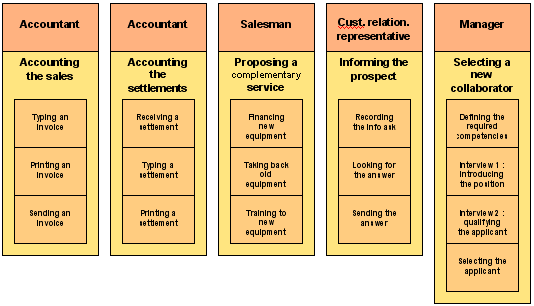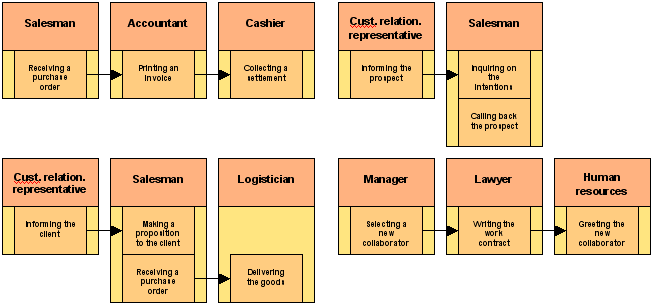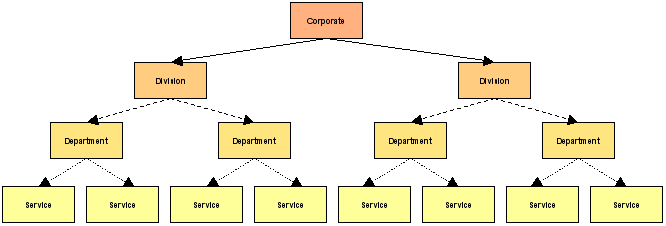Process-driven Approach of Up ! Application System
Each firm, may profitable or not, private or public, is seeking for a mission that requires the work of numerous collaborators, which are mainly the employees. In order to reach the fixed objectives, the daily work of each collaborator must be organized in a full appropriate way with the corporate mission.
The organization that results from it can be drawn according the classical model that follows:
- Atomic tasks.
- Business activities.
- Business processes.
Splitting Work into Atomic Tasks
An atomic task corresponds to a unit of work given to an individual or a set of individuals with the same competencies that take part to the organization - employee, subcontractor or partner - that corresponds to a clearly identified trade. Here are some examples:
- Typing an invoice.
- Allowing a credit for a client.
- Recording the information ask for a client.
- Doing a hiring interview.

The cutting into atomic tasks is a necessity for the two following reasons that are essential:
- The production capacity of a man is limited.
The work to supply for the mission is so important that a sole individual can be enough.
- The capacity of human specialization is limited.
The work to supply requires competencies and a so specific experience that a sole individual cannot own all for all of the atomic activities.
Gathering Atomic Tasks into Business Activities
A business activity is a set of connected atomic tasks, that may link together, and that are corresponding to a same unit of organization - a service, a department, a division or the firm. Generally speaking, the perimeter of the activity is such that its atomic tasks are corresponding to the same trade.
Here are some examples:
- Accounting the sales and the payments.
Typing the invoice, printing it, sending it, receiving the settlement, typing it and printing it. These atomic tasks are belonging to the trade of accountants.
- Delivering a supplementary service to the product offering.
Financing, taking back of old equipment, proposing education. These atomic tasks are belonging to the trade of salesmen.
- Informing any individual that is asking indication on an offer.
Typing ask for information, looking for the answer, communicating it to the prospect. These atomic tasks are belonging to the trade of customer relationship representative.
- Selecting a new collaborator.
Defining the needed competencies, the interview to introduce the position, the interview to qualify the applicant, the selection of the new collaborator. These atomic tasks are belonging to the trade of manager.

Connecting Atomic Tasks into Business Processes
A business process is a set of connected atomic tasks that are linked together. He is generally crossing several units of the organization - a service, a department, a division and the firm - and the result is that the atomic activities are not corresponding to the same trade.
Here are examples of processes:
- Invoicing a sale.
The salesman receives the purchase order.
The accountant prints the invoice.
The cashier collects the settlement.
- Making a sale.
The customer relationship representative gives an indication to the prospect.
The salesman arguments and writes a commercial proposition.
The salesman receives the purchase order.
The inventory man delivers what was ordered.
- Catching a new prospect.
The customer relationship representative gives an indication to the prospect.
The salesman inquiries to know the intentions of the prospect.
The salesman calls again the prospect.
- Hiring a new collaborator.
The manager selects a new collaborator.
The Law department writes the work contract.
The Human Resources department greets the new collaborator.

Business Topology of the Organization
In each firm we can find the essential functions that are following:
- Purchasing.
- Direction.
- Logistic.
- Production.
- Marketing.
- Quality.
- Working methods.
- Research & Development.
- Human resources.
- Services to clients.
- Sales.
Depending of the statute of the firm - may profitable or not, private or public - and also of the mission it is incarnating, these essential functions are however more or less developed, even atrophied - marketing in public services - or hypertrophied - research & development in the medicine industry.
Furthermore, ever depending of the mission it is incarnating, it must be more or less close to other actors of its environment:
- Its clients.
- Its partners.
- Its suppliers.
- Its subcontractors.
- Its bankers.
- Its competitors.
While studying the firms, we can fin four levels of organization:
- The corporate.
The scope is generally international or national.
- The division that is named general direction into public services.
The scope is generally national or regional.
- The department that is named general sub-direction into public services.
The scope is generally regional or the district.
- The service.
The scope is generally the district or local.

The result is a specific geographic spread of the organization of the firm that we called business topology, which is depending of the mission it is incarnating. Some of them will choose:
- Centralizing the purchasing at the corporate level.
There is then no division dedicated to purchasing.
- Centralizing the purchasing at the division level.
There is then no department dedicated to purchasing.
- Centralizing the purchasing at the department level.
There is then no service dedicated to purchasing.
- Decentralizing the purchasing at the service level.
There is then a local purchasing policy.
As there are more than 10 essential and independent functions for which it exists four possible deployment levels, it represents more than 4^10 = 1 048 576 possible arrangements, without taking into account the geographic perimeter that can take up several cultures!
Theorem of the Uniqueness of the Organization
We can then conclude what we can call a theorem, due to the previous demonstration:
| Theorem of the Uniqueness of the Organization Two firms, that have two different missions and that are looking for completely fulfilling,
cannot have the same organization and the same business topology. |
Theoreme of the Uniqueness of the Business Applications
Any organization needs an information system that has three uses or more:
- Defining how to work.
Tools, methods and best practices coming from experience and often a Quality Plan.
- Defining what and when to do.
Action plans, minutes and other schedules.
- Memorizing the activity.
In addition to the law aspects, the goal is to keep a organized history of the business activities such as the client list, the commercial propositions, the signed contracts, the settled invoices or to be settled ones, etc.
Since the firms must be more and more performing for the service they are delivering through their offers and more and more sparing, while increasing the quality of their products and their services, they are looking for improving and optimizing their organization by automating it. From which the automated information systems, what are using business applications, for which the spread is irreversible.
An information system is lived as a support function to the organization for the business topology of the firm. This support is more efficient if it is melt inside the organization. A modern firm that is looking to completely fulfilling its mission must thus have an information system that is strictly appropriate to its organization.
We can then conclude what we can call a theorem, due to the previous demonstration:
| Theorem of the Uniqueness of the Business Applications Two modern firms, that have two different missions and that they are looking for completely fulfilling,
cannot have the same business information system. |




